What Makes a Story a Classic Why Are Certain Stories Told Over and Over Again
"When yous leave a beautiful place, you lot conduct it with you wherever yous go," lifestyle author Alexandra Stoddard once wrote. She was referring to real-life places, but the same is truthful of fictional ones — the setting of a story can be just as affecting and memorable every bit a place you've actually visited.
But how do authors cull the right settings for their stories, and what tactics do they use to bring them to life? Discover out in this comprehensive guide to story setting, consummate with definition, examples, and tips for writing a setting that readers will retrieve forever!
What is the setting of a story?
The setting of a story is where and when it takes place. In other words, story setting involves both time period and geographic region, as well equally individual locations inside that region (such as a character's business firm, workplace, or favorite coffee store).
Setting serves every bit the backdrop to everything that happens in a story, and often contributes significantly to its atmosphere. This is why romance novels are typically set in small, cozy towns and horror stories in isolated, unnerving places (a Transylvanian castle, a cabin in the woods). Indeed, setting can be so powerful, it may even feel like a graphic symbol itself!
What are the iii types of setting?
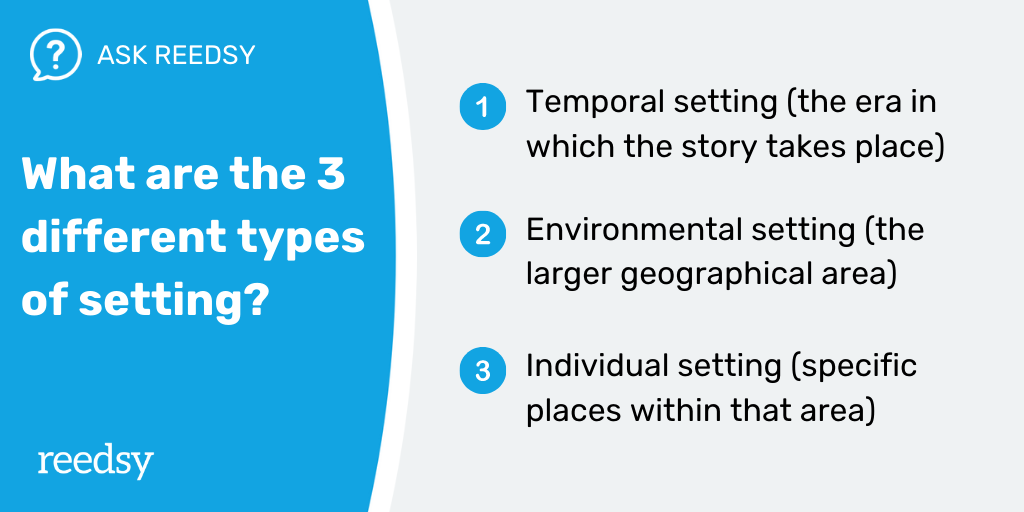
You might call back of setting in terms of 3 "types": temporal, environmental, and private. To demonstrate these concretely, let'south await at the various settings of The Slap-up Gatsby (insert physical jungle joke hither 🏙️).
- Temporal setting: the American 1920s, right in the center of the Jazz Age.
- Ecology setting: southeastern New York — New York City and Long Island.
- Individual settings: Gatsby'southward mansion, Tom and Daisy'southward mansion, Myrtle's apartment, the Plaza Hotel, and more than.
Note that just as characters tin be entire products of an writer's imagination, then often are these individual settings! (The Manhattan Plaza Hotel plainly exists in real life, just the characters' residences in The Great Gatsby do non.) Authors frequently combine real time, real identify, and invented — or at least embellished — individual settings, to ground the story in authenticity while maintaining flexibility on the details.
🎵
Tell us about your book, and we'll give you a writing playlist
It'll only take a minute!
Story setting examples
Y'all can probably call up of a dozen more setting examples. But just to solidify the notion, hither are three peculiarly potent ones, along with passages to evidence how each author paints the setting of their story.
Maycomb, Alabama in To Impale a Mockingbird
Harper Lee'southward unparalleled archetype nigh American race relations in the 1930s takes identify in the pocket-sized town of Maycomb, Alabama. Notice how the narrator, Sentry, describes Maycomb as stiflingly humid and old-fashioned, establishing the era'southward status quo of oppression and suffering:
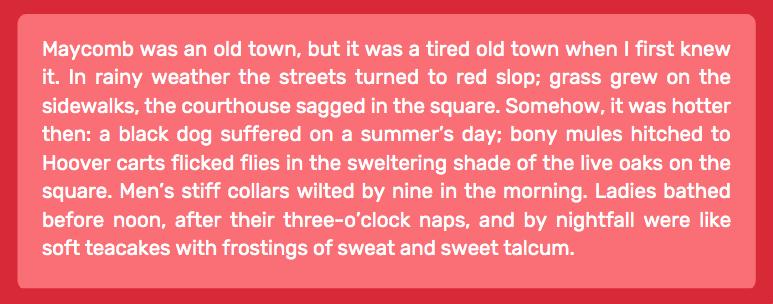
Narnia in The Lion, The Witch and the Wardrobe
Meanwhile in The Lion, The Witch and the Wardrobe, C.South. Lewis introduces Narnia as a winter wonderland total of possibilities — though it's somewhat deceiving in that the White Witch has cursed the land to eternal common cold. But it's crucial to the narrative that Narnia appears as a still, snowy place that lulls Edmund into a faux sense of security only before he meets the Witch:
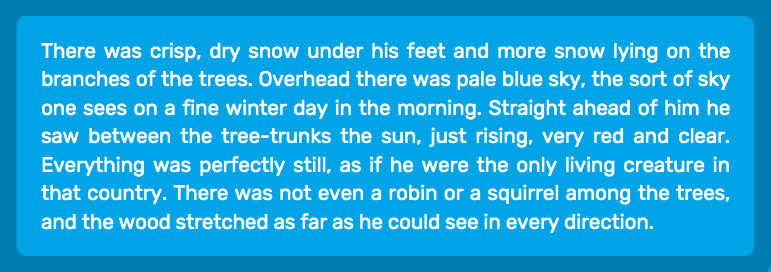
North W London in NW
For a more than contemporary example, allow's wait at a description of Due north West London in Zadie Smith's novel NW. As role of the novel's vision of London equally a polyphonic city "containing multitudes," Smith describes the area in terms of both former inhabitants and present-mean solar day scenery. To go far at the circuitous present, she must first acknowledge the past:
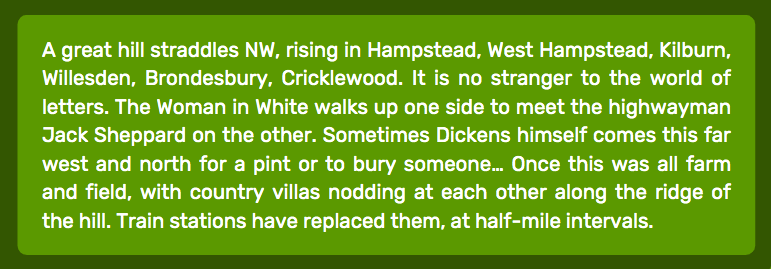
Of course, each of these passages provides only a glimpse of the rest of the book. As an writer, don't just drib a paragraph of scenery description at the start and never mention setting once again!
For setting to be effective, information technology needs to filter through the entire story — fortunately, this side by side department on how to write setting will show you how to do just that.
How to write setting in a story
1. Cull your setting wisely
Let'southward talk virtually setting suitability: as the examples to a higher place conspicuously demonstrate, every keen story hinges on setting. The Great Gatsby would not work if it were set during the Swell Depression, and it's almost impossible to imagine most of Zadie Smith's books taking place anywhere other than London.
So before you showtime writing your story, brand sure the setting fits like a glove. For some authors, this will be like shooting fish in a barrel! But for others — especially those who are doing a fleck of worldbuilding for a sci-fi or fantasy novel — choosing your setting may be a bit trickier.
To set yous (no pun intended) on the correct path, here are a few important questions to consider:
- Exactly where and when will your story take identify? Have this time to nail down the details. If it's "contemporary," does that hateful nowadays day or 10 years ago? If it's in a sure country, what city or boondocks? And if you accept multiple settings, how long will the characters spend in each one?
- Is this setting a existent identify, and if so, how much inquiry volition information technology require to convey in good organized religion? If information technology'southward merely based on a real place, how much overlap will at that place be?
- How will the setting of the story gene into the characters' lives? Will it help them or prevent them from achieving their goals? If neither, why choose this setting at all?
One time you've answered these to your satisfaction, y'all tin settle on your setting (as it were) and begin amalgam it in more detail.
2. Focus on what's unique
Not every chemical element of your setting will be worth noting, so focus on what'south unique. Every city has buildings and sidewalks, but how are they unlike from every other city's? If someone leans their head out the window, what practice they hear likewise traffic or birds? Does the boondocks square scent like bread from the local bakery, or like pollution from a nearby factory?
Become the details straight
Once more, think of your story setting almost every bit another character. Just every bit yous might fill out a grapheme profile to flesh out their quirks, you tin can contour your setting too! Here are some "setting profile" questions to get y'all started:
📜 What's the history of this area?
🌦 What is the weather like each season?
🌇 What are the biggest landmarks of this setting?
🏡 In what sorts of residences do most people alive?
🚙 How practise people tend to go around (walking, driving, etc.)?
👍 Why do people like (or dislike) living (or visiting) here?
The natural add-on to each of these questions is: and how does this affect my characters? This is where you'll tap into the well-nigh interesting features of your setting — past considering how your characters will perceive and react to what's effectually them. To quote Carmen Maria Machado: "Setting is non inert. Information technology is activated by point of view."
Now, with a articulate sense of what you want to highlight in your environmental setting, you tin move on to incorporating these features into your story.
Pro tip: When writing about places you've never been or have but seen as a tourist, over-emphasizing famous landmarks like Large Ben, the Eiffel Tower, and the Empire Country Building will make your work read like that of an amateur. To avoid this, play around on Google Street View and observe some more than quotidian hangouts for your characters!
3. Use all five senses in descriptions

As you lot describe each setting of your story, make certain yous don't just talk about how information technology looks. Instead, apply all five senses: sight, sound, aroma, impact, and even gustation.
You shouldn't use all of these in every description, nor should you continuously rehash settings you've already described. Just every bit a rule of thumb, each time your characters visit a new location — or experience that location in a new context (e.g. at dark rather than in the daytime) — you should devote a paragraph to setting the scene.
Hither's a great example of concise and multi-sensory setting description from Leigh Bardugo'south Ninth Firm:
Inside, the music thumped and wailed, the heat of bodies washing over them in a gust of perfume and moist air. The large square room was dimly lit, packed with people circling skull-shaped vats of punch, the back garden strewn with strings of twinkling lights across. Darlington was already starting to sweat.
In but three sentences, nosotros get four out of five senses:
- Sight ("dimly lit, packed with people");
- Sound ("the music thumped and wailed");
- Smell ("a gust of perfume and moist air");
- Touch/concrete sensation ("already starting to sweat").
The balance of this political party scene consists of mostly dialogue and activeness, merely Bardugo is conscientious to depict each new room the characters enter, so the reader always has a clear moving-picture show of what's happening. Indeed, the more than you show rather than tell with sense-based setting descriptions, the more you lot'll immerse readers in your story. Just don't go overboard with pages and pages of particular — zero in on what's most interesting and unique.
🖊️
Which famous author practice you write like?
Find out which literary luminary is your stylistic soulmate. Takes ane minute!
iv. Develop your characters' relationships to the setting
One time you lot've established the characters in your story, you can dig into their relationships with the setting.
These relationships can take many forms. Say your main graphic symbol has lived in the aforementioned town their entire life; they might accept a longtime fondness for information technology, or they could resent and feel trapped by the setting. Whatever you lot decide, make sure this dash comes through in your narration!
What y'all don't want is a grapheme then detached from their surroundings that their story could take identify anywhere. At bare minimum, you need them to interact with the setting in specific, realistic ways. For greater impact, use setting to challenge them, assist them, or both.
💪 Setting as a challenge vs. setting as an asset
Susan Choi does an amazing job of positioning setting equally a claiming in Trust Exercise, which begins with two young characters trying to walk to each other in a vast, highway-dense urban center:
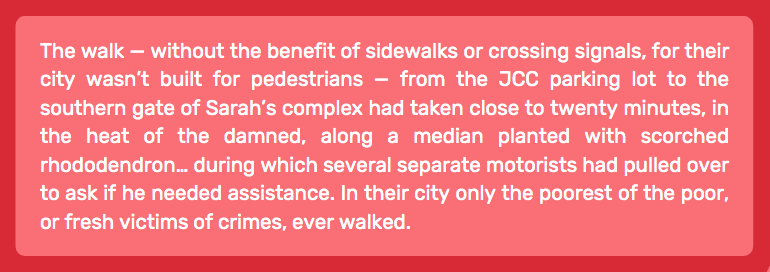
Just setting doesn't need to oppose your characters in guild to feel relevant and meaningful. Here's an example of setting as an asset, from Madeline Miller'south Circe, describing Circe exploring her new island:
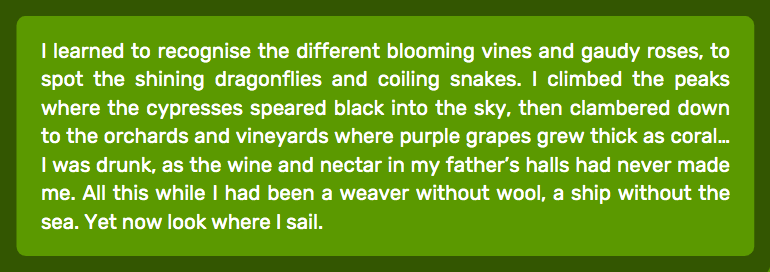
And remember, you lot're not express to i or the other! Over the course of a story, a setting may play varying roles in a character'south life, both positive and negative. Just make sure it doesn't sit at that place every bit an idle properties.
5. Keep your readers oriented
The terminal cardinal dominion of story setting is: keep your readers oriented. You lot don't want people to get distracted from your plot considering they're also busy trying to untangle where the action is happening!
Ironically, ane of the quickest ways to confuse readers is to give them too much setting detail. And then when introducing a setting, keep the description curtailed, every bit in the Ninth House example — a few evocative sentences volition do. If you accept more to say about the setting, you can incorporate information technology later.
In terms of specific directions, again, less is more. "He walked out of his flat building, turned left onto the route, then right onto the sidewalk, then another left onto another sidewalk" hardly makes for riveting storytelling. If you must utilize directions, at least ensure they're consistent! Don't say the police force station is on the due east side of town, simply to draw the sun setting (a famously western miracle) behind it in the side by side scene.
These are the kinds of problems that tin really throw readers off, even subconsciously — and then make sure yous get them straight. If yous're peculiarly worried about setting inconsistencies, you can always hire a copy editor to rummage through your work.
An editor will ensure your setting is spotless ✨
The best copy editors are hither on Reedsy. Sign upwards to run across them today.
Larn how Reedsy can assist you craft a beautiful book.
🗺️ Consider drawing a map
Whether you're edifice an elaborate world from scratch or merely desire to be as accurate as possible when representing a existent place, a map of your setting could aid (y'all might even commission an illustrator to draw one for you). This will give you lot a more concrete sense of your setting while y'all're writing, as well as streamline the reader's experience down the line.
Hither are some of our favorite fictional maps, for reference:
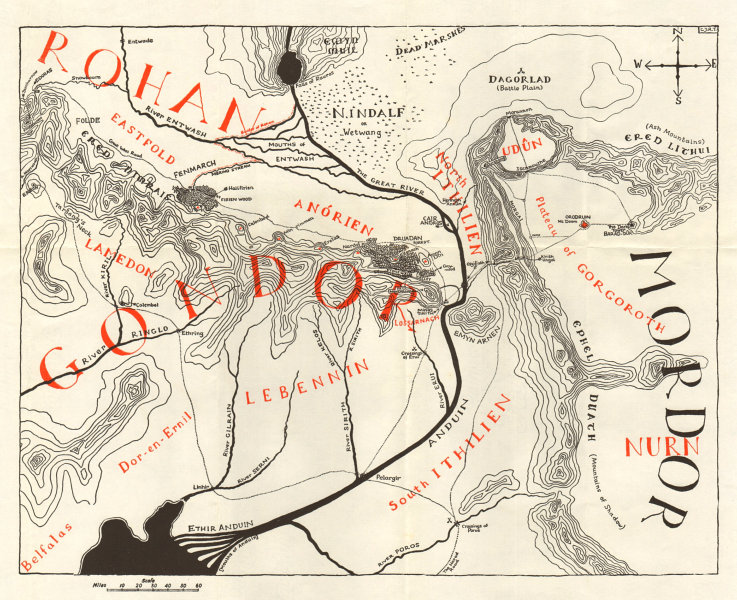
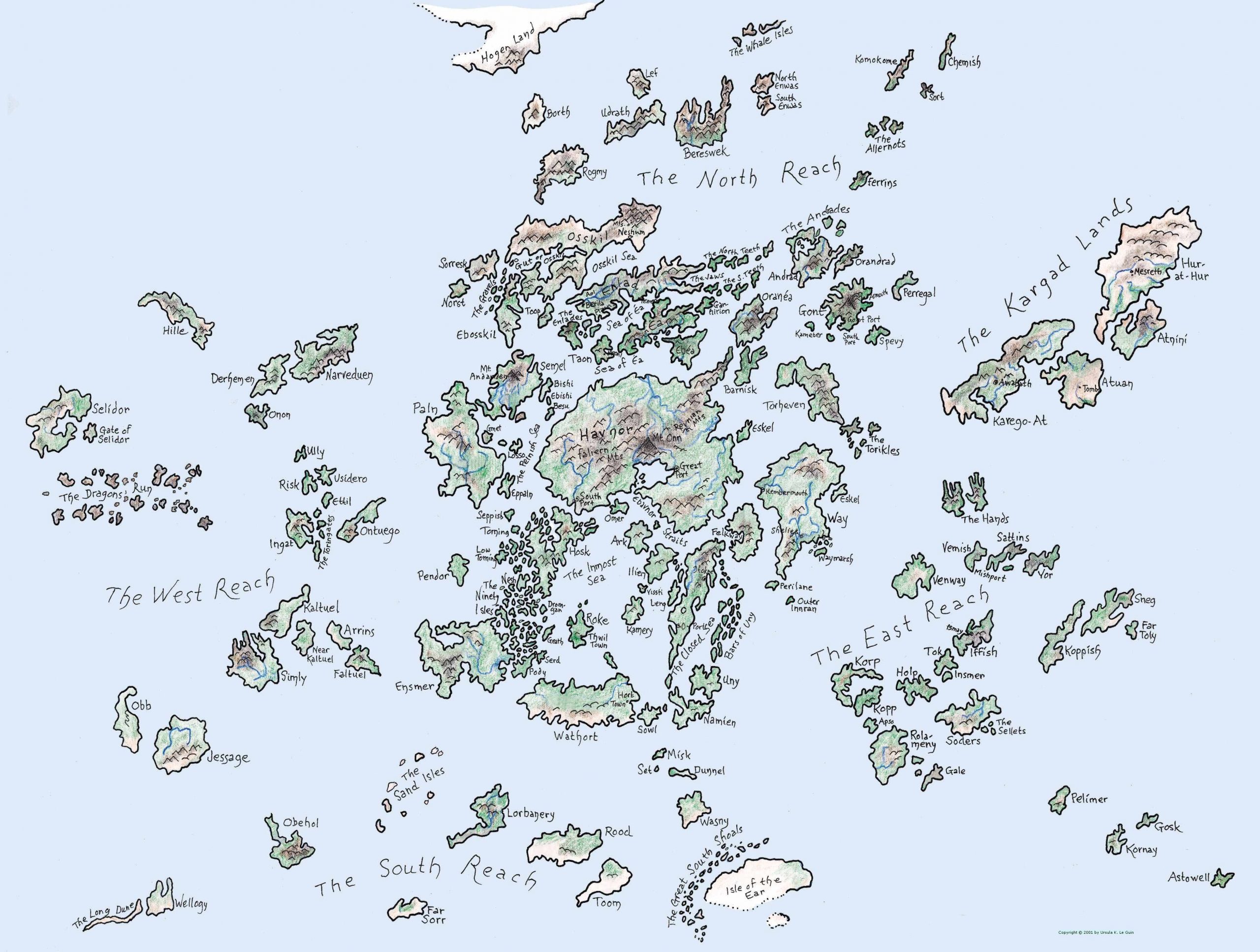
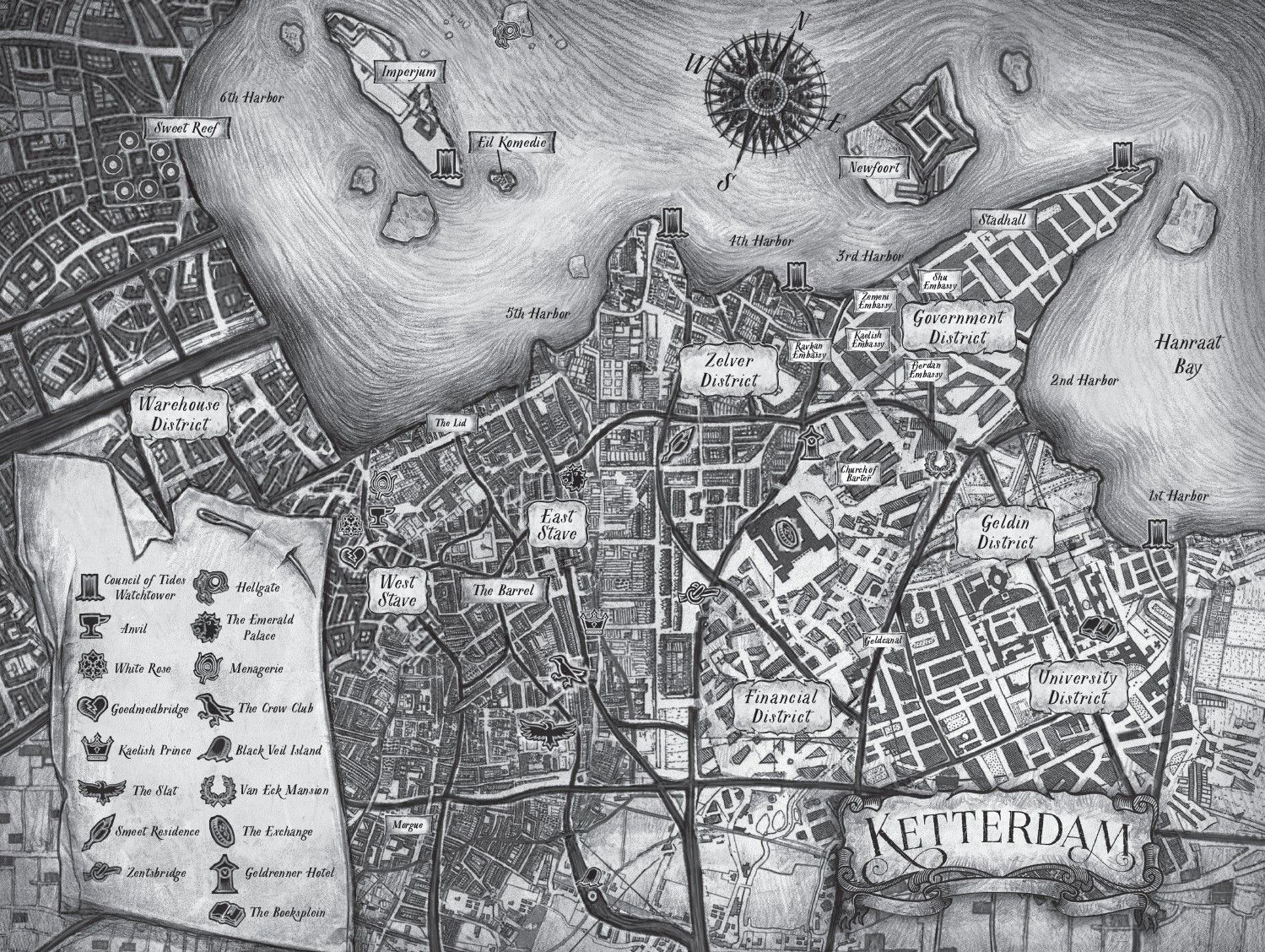
And there you take it — everything yous need to know most writing the setting of a story! With a solid sense of time and identify and compelling, character-based descriptions, you'll be well on your way to conjuring a setting, like Narnia or Jazz-Age NYC, that readers won't forget. Information technology's an essential step to becoming a better writer.
Source: https://blog.reedsy.com/setting-of-a-story/

0 Response to "What Makes a Story a Classic Why Are Certain Stories Told Over and Over Again"
Postar um comentário